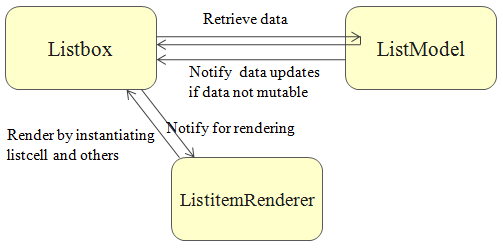List Model
Listbox and Grid allow developer to separate the view and the model by implementing ListModel. Once the model is assigned (with Listbox.setModel(ListModel)), the display of the listbox is controlled by the model, and an optional renderer. The model is used to provide data, while the renderer is used to provide the custom look. By default, the data is shown as a single-column grid/listbox. If it is not what you want, please refer to the View section for writing a custom renderer.
Model-driven Display
As shown, listbox retrieves items from the specified model[1], and then invokes the renderer, if specified, to compose the listitem for the item.
The retrieval of items is done by invoking ListModel.getSize() and ListModel.getElementAt(int).
The listbox will register itself as a data listener to the list model by invoking ListModel.addListDataListener(ListDataListener) Thus, if the list model is not mutable, the implementation has to notify all registered data listener. It is generally suggested to extend from AbstractListModel which provides a set of utilities for handling data listeners. Then, you need to only implement ListModel.getSize() and ListModel.getElementAt(int).
- ↑ The listbox is smart enough to read the items that are visible at the client, such the items for the active page. It is called Live Data or Render on Demand'.'
Small Amount of Data
If your data can be represented as a list, map, set or array (java.util.List, java.util.Map, etc.), you could use one of the default implementations, such as ListModelList, ListModelMap, ListModelSet and ListModelArray. For example,
void setModel(List data) {
listbox.setModel(new ListModelList(data));
}
If the amount of your data is small, you could load them all into a list, map, set or array. Then, you could use one of the default implementations as described above.
Alternatively, you could load all data when ListModel.getSize() is called. For example,
public class FooModel extends AbstractListModel {
private List _data;
public int getSize() {
//load all data into _data
return _data.size();
}
public Object getElementAt(int index) {
return _data.get(index);
}
}
Huge Amount of Data
If the data amount is huge, it is not a good idea to load them all at once. Rather, you shall load them only when required. However, it is generally not a good idea to load single item when ListModel.getElementAt(int) is called, since the overhead of loading from the database is significant.
Thus, it is suggested to use SQL LIMIT or similar feature to load only a subset of the data. For example, if the total number of visible items is about 30, you could load 30 or more (such as 60, depending on performance or memory is more important) if an item is not found, and discard the previous data, if any. If the next invocation of ListModel.getElementAt(int) is in the subset, we could return it immediately. Here is the pseudo code:
public class FooModel extends AbstractListModel {
public List _subset;
public int _startAt;
public Object getElementAt(int index) {
if (index >= _startAt && _subset != null && index - _startAt < _subset.size())
return _subset.get(index - _startAt);
//drop _subset, and load a subset of data, say, 60, to _subset
...
For more realist example, please refer to Small Talks: Handling huge data using ZK.
Notify for Data Updates
If the data in the model is changed, the implementation must notify all data listeners that are registered by ListModel.addListDataListener(ListDataListener). It can be done by invoking AbstractListModel.fireEvent(int, int, int) if your implementation is extended from AbstractListModel or derived.
For example, (pseudo code)
public void removeRange(int fromIndex, int toIndex) {
//remove data from fromIndex (inclusive) to toIndex (exclusive)
fireEvent(ListDataEvent.INTERVAL_REMOVED, fromIndex, index - 1);
}
public void add(int index, Object element){
//add an item at index
fireEvent(ListDataEvent.INTERVAL_ADDED, index, index);
}
public void set(int index, Object element) {
//change the item at index
fireEvent(ListDataEvent.CONTENTS_CHANGED, index, index);
}
Once a model is assigned to a component, the component will register itself as a data listener such that any change can be updated to UI.
Notice that you shall not update the component (such as listbox) directly. Rather, you shall update to the modal and then the model shall fire the event.
Control Selection
If your data model also provides the collection of the seletected items, you shall also implement Selectable. When using with a component supporting the selection (such as Listbox), the component will invoke Selectable.getSelection() to display the selected items correctly. Then, if the end user selects or deselect an item, Selectable.addSelection(Object) and Selectable.removeSelection(Object) will be called by the component to notify the model that the selection is changed.
If the model wants to change the selection at run time, it has to fire the event, such as ListDataEvent.CONTENTS_CHANGED as described above. It will cause the component to reload the data (ListModel.getElementAt(int)) and check if it is selected (Selectable.getSelection()).
All default implementations, including AbstractListModel, implement Selectable. Only thing you need to know is the implementation of AbstractListModel.addSelection(Object) and AbstractListModel.removeSelection(Object) does not fire any event, since they are designed to be called by the component. Thus, if you want to invoke them directly (i.e., you want to change the selection from the model directly), you have to invoke AbstractListModel.fireEvent(int, int, int) explicitly.
Version History
| Version | Date | Content |
|---|---|---|
